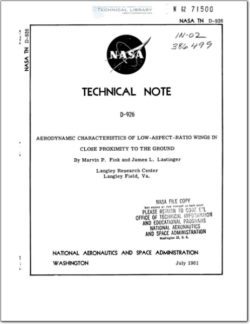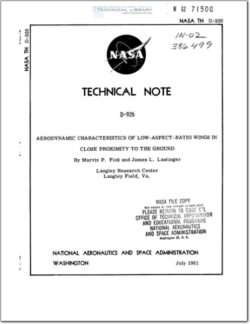NASA-TN-D-926

- Version
- 273 Downloads
- 3.30 MB File Size
- 1 File Count
- November 27, 2015 Create Date
- November 27, 2015 Last Updated
Aerodynamic Characteristics Of Low Aspect Ratio WIG

A wind-tunnel investigation has been conducted to determine the
effect of ground proximity on the aerodynamic characteristics of thick
highly cambered rectangular wings with aspect ratios of l, 2, h, and 6.
The results showed that, for these aspect ratios, as the ground was
approached all wings experienced increases in lift—curve slope and
reductions in induced drag which resulted in increases in lift-drag
ratio. Although an increase in lift-curve slope was obtained for all
aspect ratios as the ground was approached, the lift coefficient at an
angle of attack of 0° for any given aspect ratio remained nearly constant.
The experimental results were in general agreement with Wieselsberger's
ground-effect theory (NACA Technical Memorandum 77).
As the wings approached the ground, there was an increase in static
longitudinal stability at positive angles of attack. When operating in
ground effect, all the wings had stability of height at positive angles
of attack and instability of height at negative angles of attack. Wing—
tip fairings on the wings with aspect ratios of l and 2 produced small
increases in lift-drag ratio in ground effect. End plates extending
only below the chord plane on the wing with an aspect ratio of 1 pro-
vided increases in lift coefficient and in lift-drag ratio in ground
effect.
The advent of the ground-effect machine as a possible transport
vehicle has promoted considerable interest in the machine as a large
overwater transport. A ground-effect machine, to be competitive with
other carrier vehicles, would have to travel at velocities where an
aerodynamic shape would be required from drag considerations. The
question then arises as to whether a vehicle cruising at these velocities
could utilize the aerodynamic lift of a wing more efficiently than the
ground air cushion for support. It might therefore be of interest to fly
an airfoil-shaped vehicle or a wing very close to the ground. Previous
research (refs. 1 to h) has shown that a considerable increase in the
lift—drag ratio may be obtained by a wing flying in close proximity to
the ground; however, the aspect ratios studied in these investigations
(aspect ratios of 5 and 6) were higher than might be considered practi—
cal for a large vehicle flying close to the ocean surface.
| File | Action |
|---|---|
| NASA-TN-D-926-Aerodynamic-Characteristics-of-Low-aspect-ratio-WIG.pdf | Download |
Comment On This Post